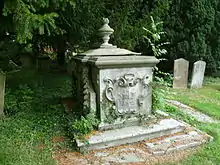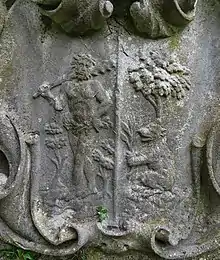Peter Meyer (merchant)
Sir Peter Meyer (c. 1664 – 9 January 1728)[1] was a major City of London merchant in the West Indies trade, merchant banker and a co-owner of the leading London international trade firm Meyer & Berenberg.


Meyer was born in Hamburg;[2] his family was from the Duchy of Holstein.[1] The son of the Hamburg merchant Jacob Meyer, he settled in London, became an English citizen in 1691 and was knighted at St James's Palace on 9 October 1714. He owned plantations on Barbados, a sugar refinery in London and the estate Poynter's Grove in Totteridge.[3][4][5]
In 1697, he married Sarah Anna Berenberg (1665-), the sister of his business partner John Henry Berenberg. She was a member of the Berenberg family and a descendant of the Amsinck family. His wife was a great-granddaughter of Hans Berenberg (1561–1626), co-founder of Berenberg Bank.[6][7]
They were the parents of the London merchant Peter Meyer (died 1756), who married Sarah; Paul, Rudolph, Elizabeth Meyer, who married her relative William Amsinck (who had become an English citizen in 1711) and Sarah, who married the Hamburg merchant Paul Heeger (died 1731). Their first child, Johan Heinrich, died young; he was baptised in 1698 and buried in 1699.[1]
He died in 1728, aged 64.[1] He was buried at Totteridge, Hertfordshire (now London)) . His monument is in the churchyard of that parish, to the north of the church. At the north end are the Meyer and Berenberg arms.[8]
Arms
These Arms are the Right of Sir Peter Meyer, Knt. and Citizen of London, and his Descendents:
References
- Cass, Frederick Charles (1885). East Barnet. London and Middlesex Archaeological Society. p. 160. Retrieved 8 July 2017.
- Davis, John R.; Manz, Stefan; Beerbühl, Margrit Schulte (2012). Transnational Networks: German Migrants in the British Empire, 1670-1914. BRILL. p. 50. ISBN 9004223495. Retrieved 8 July 2017.
- Margrit Schulte Beerbühl, The Forgotten Majority. German Merchants in London, Naturalization, and Global Trade 1660–1815. Berghahn Books, 2014. ISBN 1782384480.
- Margrit Schulte Beerbühl, "German Merchants and the British Empire," in John R. Davis, Stefan Manz, Margrit Schulte Beerbühl, Transnational Networks: German Migrants in the British Empire, 1670–1914, Brill Publishers, 2014
- Uwe Israel, Michael Matheus, Protestanten zwischen Venedig und Rom in der Frühen Neuzeit, p. 212
- "Die Berenberg-Gossler," in: Vierteljahrsschrift für Heraldik, Sphragistik und Genealogie, Vol. 9, 1881
- Hamburger Geschlechterbuch, vol. 8, Berenberg, 28
- "The Parish of East Barnet", p. 160
- Coll. Armor. Lib. VI fol. 252. Mag. Regist.
- John Warburton, London and Middlesex Illustrated: By a True and Explicit Account of the Names, Residence, Genealogy, and Coat Armour of the Nobility, Principal Merchants, and Other Eminent Families, C. and J. Ackers, 1749